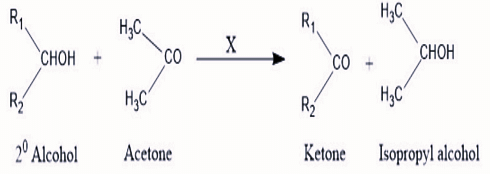The Gattermann-Koch reaction is used in the industrial preparation of benzaldehyde. The electrophile involved in this reaction is
HCO+
- HCl + CO$_2$ + anhydrous AlCl$_3$
CO+
- CO + anhydrous AlCl$_3$
The Correct Option is A
Approach Solution - 1
The Gattermann-Koch reaction is an electrophilic aromatic substitution used for the synthesis of benzaldehyde from benzene. It involves the generation of an electrophile which reacts with the benzene ring. To identify the correct electrophile, we need to evaluate the options given:
- HCO+
- HCl + CO2 + anhydrous AlCl3
- CO+
- CO + anhydrous AlCl3
In the Gattermann-Koch reaction, the electrophile is formed when carbon monoxide (CO) reacts with hydrochloric acid (HCl) in the presence of a Lewis acid catalyst, usually anhydrous aluminum chloride (AlCl3). This reaction generates the formyl cation (HCO+), which then acts as the electrophile in the reaction with benzene to form benzaldehyde.
Therefore, the correct electrophile involved in the Gattermann-Koch reaction is: HCO+.
Approach Solution -2
The Gattermann-Koch reaction is a method used to introduce an aldehyde group (-CHO) directly into an aromatic ring. It involves reacting benzene or a substituted benzene with carbon monoxide (CO) and hydrochloric acid (HCl) in the presence of anhydrous aluminum chloride (AlCl3) as a catalyst.
The electrophile generated in this reaction is the formyl cation (HCO+), which is formed through the interaction of CO and HCl with AlCl3.
Here's a breakdown of the electrophile formation:
CO + HCl + AlCl3 → HCO+[AlCl4]-
The formyl cation (HCO+) is the electrophile that attacks the aromatic ring.
Let's analyze the given options:
- Option 1: CO+: This is not the correct electrophile.
- Option 2: HCl + CO2 + anhydrous AlCl3: CO2 is not involved in the Gattermann-Koch reaction.
- Option 3: HCO+: This is the correct electrophile, the formyl cation.
- Option 4: CO + anhydrous AlCl3: This combination does not directly form the electrophile; HCl is also required.
Therefore, the correct answer is:
Option 1: HCO+
Top Questions on carbonyl compounds
- Which of the following are neutral?
- KEAM - 2025
- Chemistry
- carbonyl compounds
- Acetone can be converted to 2-methylpropan-2-ol using:
- KEAM - 2025
- Chemistry
- carbonyl compounds
- The correct stability order of carbocations is
- JEE Main - 2024
- Chemistry
- carbonyl compounds
- According to Oppenauer Oxidation reaction, oxidation of secondary alcohol to ketone by reagent (X) in acetone takes place, what is "X" :

- GPAT - 2024
- Organic Chemistry
- carbonyl compounds
- In the following compounds, what is the increasing order of their reactivity towards nucleophilic addition reactions?
- CUET (UG) - 2024
- Chemistry
- carbonyl compounds
Questions Asked in CUET exam
- Five people—A, B, C, D, and E—are sitting in a row facing north. A is to the immediate right of D. B is at one of the ends. C is sitting between E and A. Who is sitting exactly in the middle?
- CUET (UG) - 2025
- Ordering and Ranking
- A person walks 10 m North, then turns right and walks 5 m, then turns right again and walks 10 m. What direction is he facing now?
- CUET (UG) - 2025
- Direction sense
- Which of the following is a polysaccharide?
- CUET (UG) - 2025
- Biomolecules
- A train crosses a platform 200 m long in 36 seconds and a pole in 18 seconds. Find the speed of the train.
- CUET (UG) - 2025
- Speed, Time and Distance
- If \( 3 \times 4 = 25 \), \( 5 \times 2 = 27 \), \( 6 \times 3 = 39 \), then what is \( 7 \times 5 = ? \)
- CUET (UG) - 2025
- Logical Reasoning